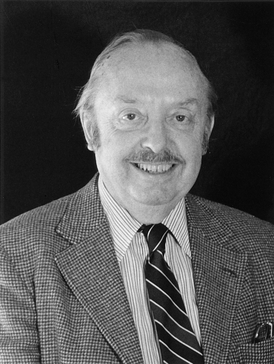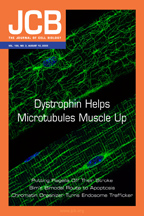
George Emil Palade was a Romanian-American cell biologist. Described as "the most influential cell biologist ever", in 1974 he was awarded the Nobel Prize in Physiology or Medicine along with Albert Claude and Christian de Duve. The prize was granted for his innovations in electron microscopy and cell fractionation which together laid the foundations of modern molecular cell biology, the most notable discovery being the ribosomes of the endoplasmic reticulum – which he first described in 1955.
Weibel–Palade bodies (WPBs) are the storage granules of endothelial cells, the cells that form the inner lining of the blood vessels and heart. They manufacture, store and release two principal molecules, von Willebrand factor and P-selectin, and thus play a dual role in hemostasis and inflammation.

Albert Claude was a Belgian-American cell biologist and medical doctor who shared the Nobel Prize in Physiology or Medicine in 1974 with Christian de Duve and George Emil Palade. His elementary education started in a comprehensive primary school at Longlier, his birthplace. He served in the British Intelligence Service during the First World War, and got imprisoned in concentration camps twice. In recognition of his service, he was granted enrolment at the University of Liège in Belgium to study medicine without any formal education required for the course. He earned his Doctor of Medicine degree in 1928. Devoted to medical research, he initially joined German institutes in Berlin. In 1929 he found an opportunity to join the Rockefeller Institute in New York. At Rockefeller University he made his most groundbreaking achievements in cell biology. In 1930 he developed the technique of cell fractionation, by which he discovered the agent of the Rous sarcoma, as well as components of cell organelles such as the mitochondrion, chloroplast, endoplasmic reticulum, Golgi apparatus, ribosome, and lysosome. He was the first to employ the electron microscope in the field of biology. In 1945 he published the first detailed structure of cell. His collective works established the complex functional and structural properties of cells.

Pühalepa Parish was a rural municipality of Hiiu County, Estonia.

Keith Roberts Porter was a Canadian-American cell biologist. He created pioneering biology techniques and research using electron microscopy of cells. Porter also contributed to the development of other experimental methods for cell culture and nuclear transplantation. He was also responsible for naming the endoplasmic reticulum, conducting work on the 9 + 2 microtubule structure in the axoneme of cilia, and coining the term "microtrabecular lattice." In collaborations with other scientists, he contributed to the understanding of cellular structures and concepts such as compartmentalization, flagella, centrioles, fibrin, collagen, T-tubules and sarcoplasmic reticulum. He also introduced microtome cutting.

Grigore T. Popa University of Medicine and Pharmacy is a public university-level medical school located in Iași, Romania. Named in honor of the scientist Grigore T. Popa, it is classified by the Ministry of Education as an advanced research and education university.
James Douglas Jamieson was an American cell biologist and professor at the Yale School of Medicine. His early research in cell biology of pancreatic acinar cells in the lab of George Palade established the function of the Golgi apparatus in secretory protein trafficking.
Marilyn Gist Farquhar was a pathologist and cellular biologist, Professor of Cellular and Molecular Medicine and Pathology, as well as the chair of the Department of Cellular and Molecular Medicine at the University of California, San Diego School of Medicine, who previously worked at Yale University from 1973 to 1990. She has won the E. B. Wilson Medal and the FASEB Excellence in Science Award. She was married to Nobel Laureate George Emil Palade from 1970 to his death in 2008. Her research focuses on control of intracellular membrane traffic and the molecular pathogenesis of auto immune kidney diseases. She has yielded a number of discoveries in basic biomedical research including: mechanisms of kidney disease, organization of functions that attach cells to one another, and mechanisms of secretions.
Science and technology are well developed in Romania, with the presence of several universities and research institutes, and have a distinguished tradition going back more than a century. Romania was ranked 48th in the Global Innovation Index in 2024.

The Annual Review of Cell and Developmental Biology is a peer-reviewed scientific journal published by Annual Reviews since 1985. It releases an annual volume of review articles relevant to the fields of cell biology and developmental biology. Its editor has been Ruth Lehmann since 2018. As of 2024, its impact factor is 11.4. As of 2023, Annual Review of Cell and Developmental Biology is being published as open access, under the Subscribe to Open model.

Ewald Rudolf Weibel HonFRMS was a Swiss anatomist and physiologist and former director of the Institute of Anatomy at the University of Bern. He was one of the first scientists to describe the endothelial organelles Weibel–Palade bodies, which are named after him and his Romanian-American colleague George Emil Palade. He was known for his work on the anatomy of gas exchange in lungs on multiple spatial scales using stereology.
Web intelligence is the area of scientific research and development that explores the roles and makes use of artificial intelligence and information technology for new products, services and frameworks that are empowered by the World Wide Web.

The George Emil PaladeUniversity of Medicine, Pharmacy, Science, and Technology of Târgu Mureș is a public university in Târgu Mureș, Romania that was founded in 1948. Classified as a research and education university by the Ministry of Education, it is one of the 6 traditional medical schools in Romania beside Bucharest, Cluj-Napoca, Craiova, Iași and Timișoara, all being founded before the 1989 Romanian revolution. The university is named after the prominent scientist George Emil Palade.

The Journal of Cell Biology is a peer-reviewed scientific journal published by Rockefeller University Press.
Ala is a village in Hiiumaa Parish, Hiiu County in northwestern Estonia.

Estonia, officially the Republic of Estonia, is a country by the Baltic Sea in Northern Europe. It is bordered to the north by the Gulf of Finland across from Finland, to the west by the sea across from Sweden, to the south by Latvia, and to the east by Lake Peipus and Russia. The territory of Estonia consists of the mainland, the larger islands of Saaremaa and Hiiumaa, and over 2,300 other islands and islets on the east coast of the Baltic Sea, covering a total area of 45,335 square kilometres (17,504 sq mi). Tallinn, the capital city, and Tartu are the two largest urban areas. The Estonian language is the official language and the first language of the majority of the population of 1.4 million.
Philip Siekevitz was an American cell biologist who spent most of his career at Rockefeller University. He was involved in early studies of protein synthesis and trafficking, established purification techniques to facilitate study of the cell nucleus, worked with Nobel Prize in Physiology or Medicine winner George Palade on cell membrane dynamics, and published extensively on the subject of postsynaptic density.

Hiiumaa Parish is a rural municipality of Estonia on the island of Hiiumaa. Hiiumaa Parish was established by merging Emmaste Parish, Hiiu Parish, Käina Parish and Pühalepa Parish after the municipal elections held on 15 October 2017. Kärdla is the administrative center of the municipality. The current mayor (vallavanem) is Hergo Tasuja. The municipalities of Emmaste and Pühalepa contested their forced merger with Hiiu and Käina to form the new Hiiumaa municipality, which includes the whole island and what is Hiiu County.
Peter Novick is an American scientist who holds the George Palade Endowed Chair in the Department of Cellular and Molecular Medicine at the University of California, San Diego. His research interests focus on the biology of cell membranes, particularly the secretory pathway and other aspects of membrane trafficking and intracellular transport.

















